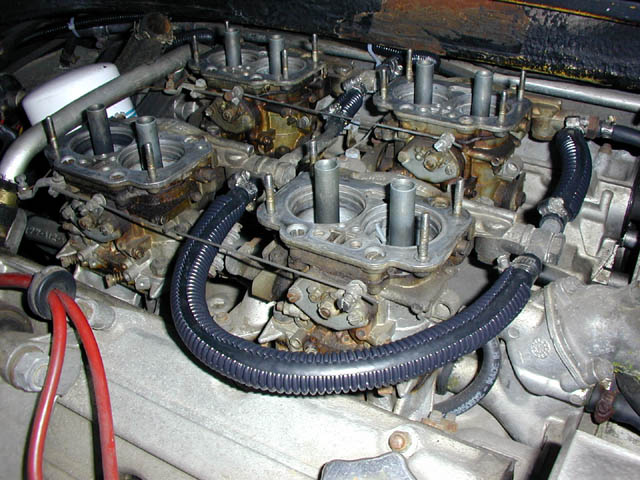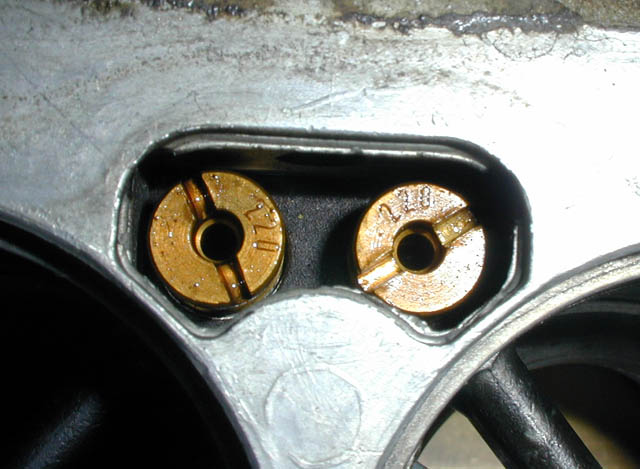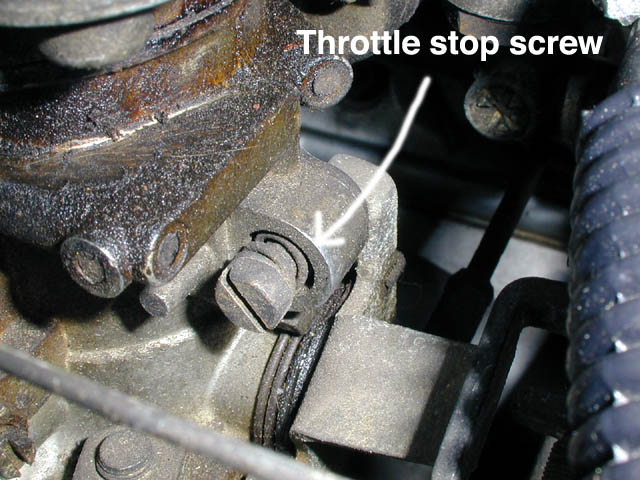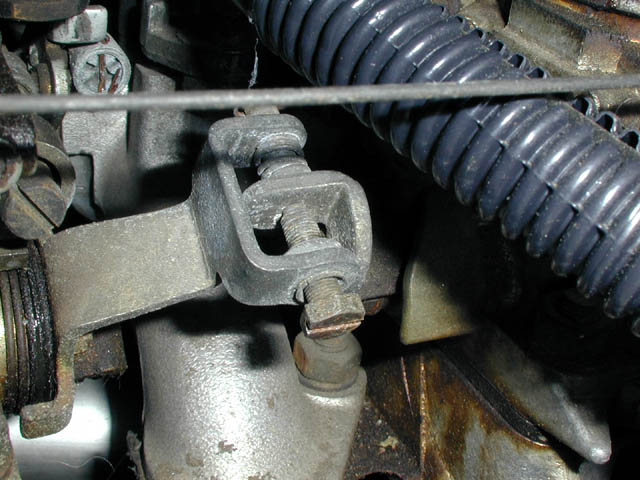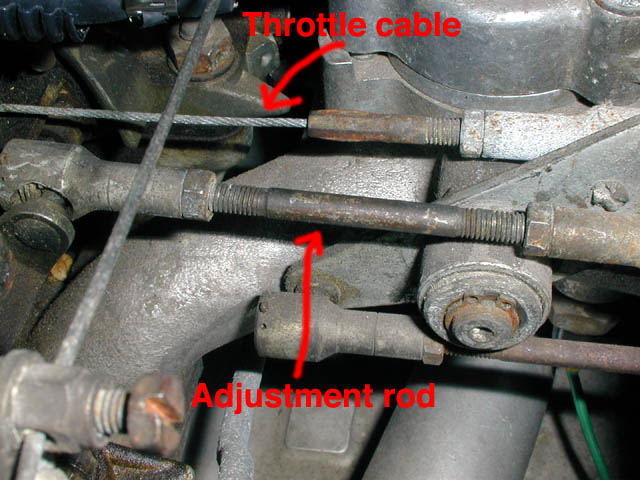Carb Synch Tutorial: Ferrari 308
series
By The Birdman
If you are reading this you probably already know what
carburetor synchronization is, but just to be complete, it
is getting all the carbs working together as a matched set
so that they all feed the same mixture to the engine. Since
on a 308 there are 4 carbs (each with two barrels) and they
feed different cylinders, if one carb is not adjusted the
same as the others, different cylinders will be getting a
different mixture and that makes your car run poorly.
Synching involves setting the linkages between the carbs so
they all work together at the same rate, and also usually
setting the mixtures on each carb as well.
Before you sync the carbs you should be
sure that the floats are set right (they control the
fuel level in the bowls of the carbs) and the jets are
clean. Checking the floats requires taking the tops of the
carbs off and measuring them. This is outside the scope of
this tutorial but here
is the procedure. You should pull the main jets and the
idle jets first. They can be visually inspected, or soaked
overnight in fuel injector cleaner just to be sure they are
clear, then re-installed. If you have a very hard time
getting your carbs synched, you may have an air leak
someplace such as a manifold gasket or vacuum line. The
whole procedure should not take more than a couple hours,
even for someone that has never done it. I recommend that
you do this procedure outside, because it involves running
the car for a while and standing over the engine
compartment!
The major adjustments you will make are to the air bypass
screws, idle mixture screws, throttle stop screws and
linkage. First, here are some pictures of what you will see
when you pull off the airbox.
STEP 1: Start and warm the car. The best way is a
short drive.
STEP 2: REMOVE AIRBOX
To get the airbox off you need to pull the cover and the
element, then remove the 16 nuts holding the "trumpets"
down. Remove the trumpets and the airbox will lift off. You
also have to remove the crankcase breather hose from
underneath the airbox as you remove it. Be careful not to
drop anything down the throats of the carbs!
|
|
There is more than one way you can go about synchronizing
the carbs. I'm going to outline the procedure described in
the 308 GT4 service manual, which applies to all 308
GT4/GTB/GTS series cars. Please note that this is not only
the way Ferrari recommends, but it is the most logical
approach to this process and I recommend that you do it
the way this is outlined. I have heard all kinds of strange
stories about using the air bypass screws to do the synch,
etc. and these are wrong. Air bypass screws are not for
synching all the carbs, they are only for synching the two
barrels in each carb to each other. I'll get to that.
Just follow this procedure and you can't go wrong, assuming
your floats are set right, your jets are the right size and
clean, and there are no air leaks. Honest, this isn't rocket
science.
Once you get the airbox off and before you start
tweaking, start the car up again and re-warm the engine.
Do not go driving around without an airbox or air
filter. At best it's not good for the car because dirt
gets into the engine, at worst, your car can catch on fire
because the air box is a spark suppressor. Yes, I actually
know someone who had his car burn to the ground because he
drove it without the airbox and it caught on fire.
STEP 3: Close all air bypass screws (unlock the
locking nut and screw in the adjuster all the way).
STEP 4: Open all idle mixture screws 3 turns from
closed (a good rough starting point). This means: close them
all from where ever they were set, then open them again 3
full turns (360 degrees each turn) from closed.
|
|
STEP 8: Once everything is pretty close at 1500
RPM, you are now done with the linkage adjustments and will
not need to touch them again. Now we adjust the synch at
idle. To do this, adjust the throttle cable adjuster in
again to drop the engine speed down to closer to idle (900
RPM). Keep in mind that since your idle screws (throttle
stop screws) are backed way out of the way, if you loosen
the throttle cable too much, the engine will stall. The next
step is to get it so that the butterfly valves are now
resting on the throttle stop screws and the throttle cable
is loose with a tiny bit of slack so it is not affecting the
idle speed. You adjust the idle speed by setting the
throttle stop screws on the front and back banks at the same
point, so the engine idles at about 900 RPM.
STEP 9: ADJUST THROTTLE STOP SCREWS
You can get a pretty serious imbalance between the front and
back carb flow at idle if you get the throttle stop screws
unevenly set. They need to be set so that they each are
holding the bank a little because there is enough play in
the linkage that if only one is doing the holding, the other
bank will be very different. Use the syncrometer to get the
flow the same at idle, while holding the idle speed at about
900. This takes time. The flow at idle will be around 3.5 to
4 kg/hr per barrel. If you get a lot of sputtering and
backfiring, making the idle erratic and hard to adjust, open
the mixture screws another turn or two. If the mixture is
too lean at idle the carbs will spit and the idle will be
irratic. (If this still happens with the idle screws all the
way out, read below my comments on idle jets).
STEP 10: AIR BYPASS SCREWS
Once the carbs are close at idle (you will never get them
perfect so try not to be too anal retentive about it!) you
can adjust the air bypass screws. Many people are confused
about what these are for. These screws are used only to
adjust the barrels on each carb to each other. They work by
allowing some air to bypass the butterfly valve so that you
can get the flow matched between the two barrels of a single
carb. So what you do is pick a carburetor and measure the
flow between the left and right barrel. Take the one that
has the lower flow and open the air bypass screw on
that barrel until the flow is matched to the other barrel,
then lock them both with the locking nuts. One air bypass
screw always stays closed. On any carb, there will
always be one air bypass screw that is closed and MAYBE the
other will be open, because you only use the one on the
barrel that has the lower flow. Please note that if the flow
is pretty close between the two barrels, you can leave both
air bypass screws closed, which is the optimum way for them
to be set. On my 308, out of 8 bypass screws, only one is
open. Once they are set, remember to lock them down
(gently!) with the lock nuts. Never tighten anything too
tightly on these carbs. They are made of soft aluminum and
it's very easy to strip threads.
STEP 11: IDLE MIXTURE
Idle mixture is tough to set without a CO monitor. In
general, if the car is spitting, backfiring or idling
poorly, they are usually too lean. For some reason, 308
engines tend to idle better rich, so most owners end up
having them run a tad rich at idle if emissions compliance
isn't a factor. The general procedure without a CO monitor
is to open the idle mixture screws, one at a time, while
listening to the engine and monitoring the flow. As you open
the screw (enrichen the mixture) the engine will run faster
and faster, as that cylinder gets richer and richer, until
it will actually start to get slower as you continue to open
the screw and the mixture gets way too rich. You want to
open it until the engine just starts to run slower (way too
rich), then close the screw about 1/4-1/2 turn. Because they
used different lengths of tapers on these adjuster screws at
different times, there is no definitive way to say where
they should be set, but most 308 owners report setting them
between 2 and 5 turns out from fully closed. Now repeat this
procedure with each mixture screw.
Once you start adjusting the mixture at idle, the idle
speed will start going all over. Now you have to go back and
tweak the idle speed again using the flowmeter and the
throttle stop screws. Everything affects everything else, so
this process can take an hour or so. When the carbs are
synched, a 308 will idle perfectly, like a purring cat.
STEP 12: ONE LAST THING
Turn the engine off and push the gas pedal to the floor
several times to be sure that the throttle doesn't stick
open and it returns to the throttle stop each time. Put the
airbox back on, start it back up, and take it for a
drive. Your car should be idling at
about 900 RPM with all the flows the same and it should run
smoothly to redline. It should run a lot better if the car
was out of whack.
A NOTE ABOUT IDLE JETS AND PROGRESSION HOLES
Contrary to popular belief, the idle jets in these Webers do
more than provide the fuel at idle. The idle jets feed the
idle orifice as well as the progression holes. These
progression holes are tiny orifices that get uncovered by
the butterfly valve as it opens. They "progressively"
provide more fuel during that very "touchy" phase between
the closed (idling) throttle and the point where the main
jets take over. During around town driving, where your foot
is on and off the throttle, most of the fuel is being
supplied by the progression holes, via the idle jets, not
the main jets. Opinions vary on this, but most people agree
that the main jets don't start to make a significant
contribution to power until between 3000-4000 RPM. What does
this mean? It means that the idle jets make a big difference
in how your car runs. The idle mixture screws only adjust
how much fuel reaches the first progression hole ("idle
orifice") which meters fuel for idling only. As you are
driving around town, the idle jets provide most of the fuel
to keep your engine running, and it is not adjustable
with the idle mixture screws. What I'm telling you is that
if your car runs well at high RPM but not as well at low
RPM, the idle jets need to be looked at. They could be
clogged, or too small. The late model carb 308 series (1978
and later) were fitted with small idle jets to make them run
lean to pass emissions. They often pop and misfire at low
RPM. Many people think that by opening up the idle mixture
screws they can richen up the mixture, but it only affects
the first progression hole, and rarely helps the performance
of the car in actual driving. Going up a size (for example
from a .50 to a .55 or from a .55 to a .60) idle jet often
works wonders. It made my car run like a whole different car
for $25 in new jets. I have also heard something from more
than one carb expert about modern fuels needing bigger jets
than '70's gasoline and that even early carb 308's often
benefit from a slightly richer jetting. My car is a '77 and
I went from .55 (stock) to .60 jets and it completely cured
the popping and misfiring instantly. My car also prefers
1.40 Main jets to the stock 1.35s.
A NOTE ABOUT BACKFIRING WHEN YOU SHUT THE CAR
OFF
A lot of 308 owners report this issue. In my experiments, it
seems totally related to idle speed. If your idle speed is
too high, it will backfire when you shut it off, no matter
how well your engine is tuned, how well the carbs are
synched or how perfect your jetting and timing. It is my
experience that since a lot of 308s are not properly
synched/jetted, they idle poorly. Becuase they idle poorly,
the idle speed is set high to compensate. The result is
backfiring. You can test this yourself. If your car
backfires, put the car in gear and use the clutch to slow
the engine to below 1000 RPM just as you turn off the key.
It won't backfire. All you have to do to cure the backfire
is synch the carbs, set the idle at 900 where it belongs,
and it should go away. The problem seems aggravated by the
fact that 308s like to be jetted a little rich. If you lean
them down until they don't backfire, they often don't run
very well.
Confused about what all the stuff on the carbs does? Read
this excellent
article which explains it.
THE FINE PRINT: This service procedure is
provided as the personal experience of the author who is in
no way an expert, so take this advice with what you
paid for it. I am not liable if you blow yourself
up!
|

